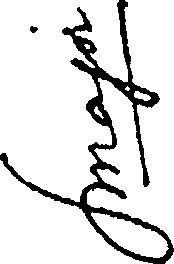Indian Institute of Technology Guwahati %28IIT-G%29 2005 JAM Geology - Question Paper
JAM 2005 Geology
2005 - GG
2005 - GG
|
Test Paper Code : GG Time : 3 Hours Max. Marks : 300 INSTRUCTIONS 1. The question-cum-answer book has 28 pages and has 44 questions. Please ensure that the copy of the question-cum-answer book you have received contains all the questions. 2. Write your Roll Number, Name and the name of the Test Centre in the appropriate space provided on the right side. 3. Write the answers to the objective questions against each Question No. in the Answer Table for Objective Questions, provided on page No. 7. Do not write anything else on this page.
4. Each objective question has 4 choices for its answer: (A), (B), (C) and (D). Only ONE of them is the correct answer. There will be negative marking for wrong answers to objective questions. The following marking scheme for objective questions shall be used : (a) For each objective question, you will be awarded 3 (three) marks if you have written only the correct answer. (b) In case you have not written any answer for a question you will be awarded i!!l 0 (zero) mark for that question. (c) In all other cases, you will be awarded -1 (minus one) mark for the question. ! ! ; 5. Answer the subjective question only in the space provided after each question. 6. Do not write more than one answer for the same question. In case you attempt a subjective question more than once, please cancel the answer(s) you consider wrong. Otherwise, the answer appearing last only will be evaluated. 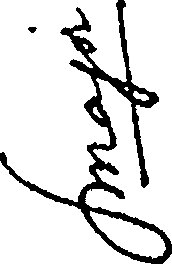 7. All answers must be written in blue/ black/blue-black ink only. Sketch pen, pencil or ink of any other colour should not be used. 8. All rough work should be done in the space provided and scored out finally. INS' 9. No supplementary sheets will be provided to the candidates. 10.Logarithmie Tables / Calculator of any kind / cellular phone / pager / electronic gadgets are not allowed. 11.The question-cum-answer book must be returned in its entirety to the Invigilator before leaving the examination hall. Do not remove any page from this book. |
READ THE INSTRUCTIONS ON THE LEFT SIDE OF THIS PAGE CAREFULLY
Test Centre : Do not write your Roll Number or Name anywhere else in this question-cum-answer book. I have read all the instructions and shall abide by them. Signature of the Candidate I have verified the information filled by the Candidate above. Signature of the Invigilator | ||||||||||||||||
NOTE : Attempt ALL the 44 questions. Questions 1-30 (objective questions) carry three marks each and questions 31 - 44 (subjective questions) carry fifteen marks each.
Write the answers to the objective questions ONLY in the Answer Table for Objective Questions provided on page 7.
1. The incorrectly matched pair among the following is
(A) forsterite - orthosilicate
(B) augite double chain silicate
(C) biotite - sheet silicate
(D) orthoclase - framework silicate
2. Of the following, pick the mineral that is not associated with pegmatites
(A) Mica
(B) Emerald
(C) Feldspar
(D) Kyanite
3. The lithosphere of the earth is made up of
(A) crust
(B) crust and upper mantle
(C) crust and part of the upper mantle
(D) upper mantle
4. The continuous line on a folded surface connecting points of maximum curvature is known as the
(A) axis
(B) axial trace
(C) hinge line
(D) crest
5. Vertebrate fossils are most important for the study of the
(A) Intratrappean beds
(B) Gondwana rocks
(C) Siwalik rocks
(D) Zewan beds
6. Varves are typical products of
(A) flood planes
(B) periglacial lakes
(C) coastal lagoons
(D) coal basins
7. Supergene sulfide enrichment occurs
(A) below the water table
(B) above the water table
(C) at depths independent of water table
(D) both above and below the water table
8. A mineral has steel-grey colour, metallic lusture, two sets of perfect octahedral cleavage and very high specific gravity. The mineral is
(A) galena
(B) magnetite
(C) molybdenite
(D) barite
9. Artesian condition results when the
(A) water table is perched
(B) aquifer is unconfined
(C) piezometric surface is above ground level
(D) watertable is above ground level
10. The Devonian marker horizon in the Himalayas is known as
(A) Lipak Formation
(B) Muth Quartzite
(C) Po Formation
(D) Syringothyris Limestone
11. If a crystal face has Weiss parameters of la, 2b, V2 c, its Miller indices will be
(A) 124
(B) 214
(C) 421
(D) 412
12. Among the following, commercial asbestos is
(A) cristobalite
(B) chrysotile
(C) cryolite
(D) chaistolite
13. Exsolution texture results from
(A) eutectic crystallization
(B) phase separation in the solid state
(C) crystallization following phase separation
(D) replacement
14. When crystals are in equilibrium with their coexisting melt in the bi-component albite-anorthite system, the Ca/Na ratio of crystals will at all times be
(A) higher than that of coexisting melt
(B) lower than that of coexisting melt
(C) same as that of coexisting melt
(D) same as that of the initial melt
15. A river that maintains its course by valley deepening during uplift is termed
(A) subsequent
(B) insequent
(C) consequent
(D) antecedent
16. Among the following the glacial landform is
(A) hanging valley
(B) bajada
(C) monadnock
(D) blind valley
17. Match the following
(i) myrmekite
(a) augite grains enclosed by laths of plagioclase
(b) intergrowth of quartz and K-feldspar
(c) vermicular quartz in plagioclase
(d) intergrowth of albite in K-feldspar
(ii) perthite
(iii) graphic
(iv) ophitic
(A) i - c, ii - d, iii - a, iv - b
(B) i - c, ii d, iii b, iv - a
(C) i c, ii - b, iii d, iv - a
(D) i - b, ii d, iii c, iv - a
18. Character of sutures is the sole criterion for recognizing the evolution of ammonoids during the
(A) Early Paleozoic Periods
(B) Late Paleozoic Periods
(C) Mesozoic Era
(D) Cenozoic Era
19. Nonconformity can be recognized by occurrence of
(A) contact effect below and above the plane of unconformity
(B) pebbles of non-sedimentary rock over the plane of unconformity
(C) paraconformable bedding planes
(D) angular discordance at the plane of unconformity
20. A metamorphic rock has garnet and omphacite. The metamorphic facies of the rock is
(A) greenschist
(B) granulite
(C) amphibolite
(D) eclogite
21. As index fossils, brachiopods were important during the
(A) Late Cretaceous
(B) Middle Jurassic
(C) Early Jurassic
(D) Late Paleozoic
22. The presence of a pallial sinus in a bivalve shell indicates its
(A) infaunal habitat
(B) epifaunal habitat
(C) planktonic habitat
(D) pelagic habitat
23. The 010 section of a monoclinic mineral necessarily shows
(A) inclined extinction
(B) straight extinction
(C) symmetric extinction
(D) undulose extinction
24. For the construction of a gravity dam choose the most favorable geological condition of the following
(A) Strata dipping downstream in narrow valley
(B) Strata dipping upstream in wide valley
(C) Strata dipping downstream in wide valley
(D) Strata dipping upstream in narrow valley
25. Of the following features, one that is not useful in determination of the order of superposition is
(A) truncated cross-bedding
(B) graded bedding
(C) mud-cracks
(D) current ripples
26. The explored part of the Moon consists dominantly of
(A) basalts and anorthosites
(B) basalts
(C) basalts and granites
(D) basalts and andesites
27. Reversal of magnetic polarity in strips of ocean floor basalt parallel to ridge axis, results due to
(A) bimodal volcanism
(B) seafloor spreading
(C) transform faults
(D) alteration of seafloor basalt
28. The amplitude of seismic waves in an earthquake of magnitude 2 on the Richter scale is larger than that of an earthquake of magnitude 1 by
(A) 100 times
(B) 10 times
(C) 2 times
(D) 1000 times
29. In a sequence of layered rock, the bedding plane indicates a single minor period of
(A) erosion
(B) sublev ation
(C) non-deposition or scour
(D) peneplanation
30. When the minimum principal stress (as) is vertical, the resultant fault is a
(A) strike-slip fault
(B) oblique-slip fault
(C) thrust
(D) normal fault
31. (a) Draw the contour maps of valleys showing the traces of outcrops indicating beds dipping downstream at an angle (i) greater than the valley gradient, (ii) less than the valley gradient. (3 + 3)
(b) Three drill holes X, Y and Z intersect a marker horizon at 945 m, 595 m and 445 m, respectively. The locations of the drill holes X, Y and Z are given below. Drill holes
Y and Z are located due north and N 30 E, respectively, from X. Make necessary constructions to determine the (i) strike of marker horizon, and (ii) amount and direction of the dip of marker horizon. (3 + 6)

32. (a) (i) Give a typical mineral assemblage of pelitic rocks of the amphibolite fades, (3)
(i) The average density of the earths crust is 2.8. Determine the lithostatic pressure (in kbar) at a depth of 10 km (given, g = 9.81 m/sec2, 1 bar = 105 Pa). (3)
(ii) Differentiate between fault scarp and fault line scarp.
(6)
(b)
An igneous rock has 47.5% quartz, 28.5% K-feldspar, 19% plagioclase, and 5% accessory minerals. Plot this composition in the ternary diagram given below. Suggest a name for the rock. (6)
Qz
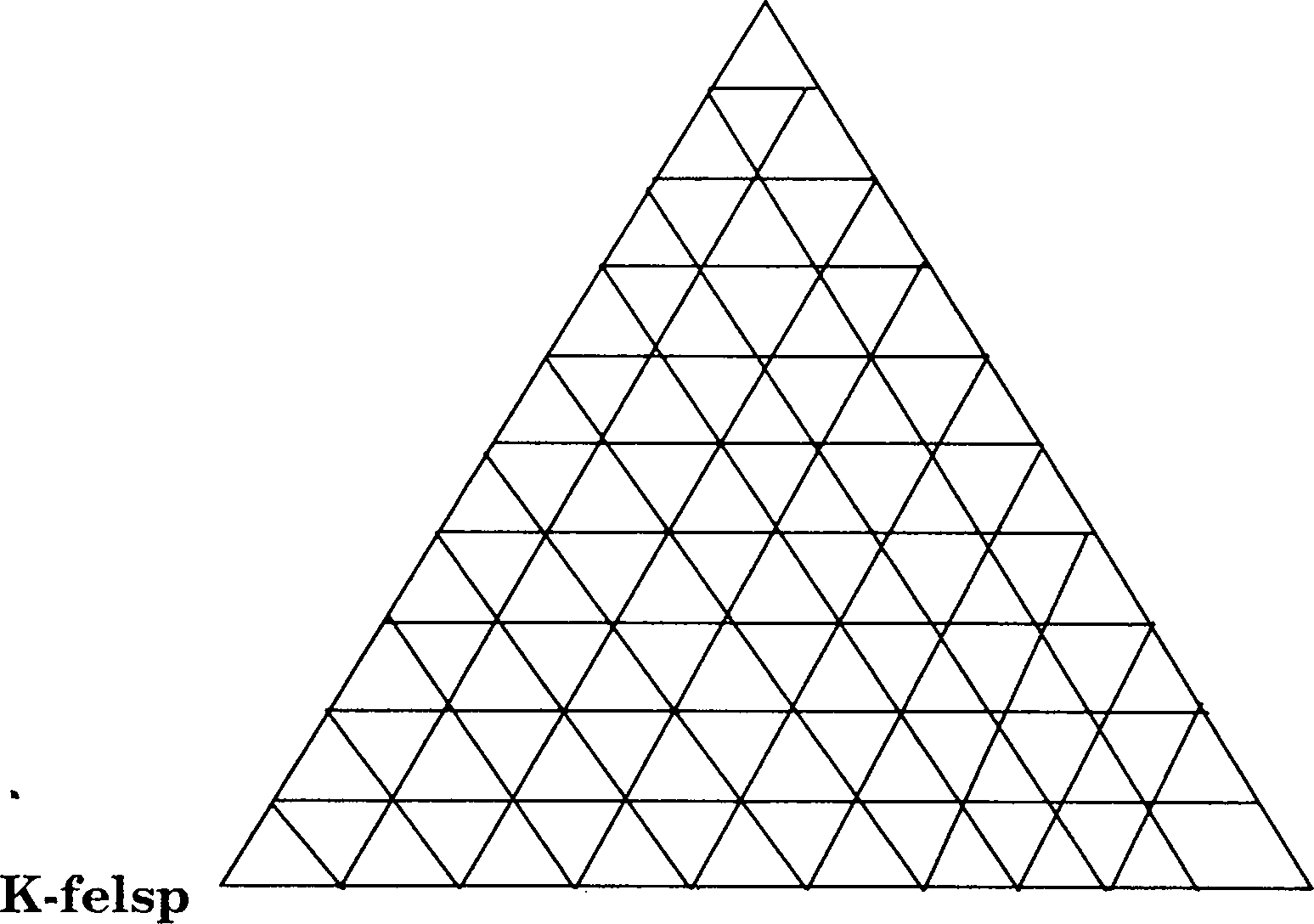
Plag.
34. (a) (i) Where are the eyes located on a trilobite cephalon with facial suture?
(ii) What happens when there is no facial suture in a trilobite cephalon?
(3 + 3)
(b) Name the commonly occurring longitudinal and transverse skeletal structures of anthozoan skeletons. (9)
35. (a) Name the factors that control the depth of the baselevel of erosion in a submarine profile across the continental shelf. (6)
(b) Define extinction, extermination and asylum of organisms in geological past. (9)
36. (a) Give one example each for observed and inferred units in stratigraphy. (6)
(b) State the ages of (i) Fenestella Shale, (ii) Uttatur Group, and (iii) Spiti Shale.
(3 + 3 + 3)
37. (a) Name the (i) oldest group of rock within the Dharwar Supergroup of South India that includes some remnants of the primordial crust, (ii) Permian group of rocks of the Damodar-Son-Narbada graben, and (iii) Cretaceous-Tertiary volcano-sedimentary sequence of the Peninsular India. (9)
(b) Name two Indian Mesozoic successions where ammonoids have been used for detailed biozonation. (6)
38. (a) Distinguish between flysch and molasse in the context of an orogen. (3 + 3)
(b) (i) Name the chief orthochemical components of both matrix and cement in carbonate rocks, (ii) a sandstone has high (>25%) feldspathic content. Name the rock. (3 + 3 + 3)
39. (a) (i) What is a hydrothermal deposit?
(ii) Give three possible sources of hydrothermal fluids.
(iii) Briefly state two important diagnostic features of hydrothermal deposits.
(3 + 3 + 3)
(b) What are gossans? Mention the significance of their occurrence. (3 + 3)
40. (a) (i) What is the principal ore of aluminium and what is its broad chemical/ mineralogical composition?
(ii) State the mechanism of formation of such ores in nature.
(iii) Mention the parent rock, climatic and topographic controls on formation of these ores. (3 + 3 + 3)
(b) What are orthomagmatic deposits? Describe briefly two orthomagmatic processes leading to ore deposits. (3 + 3)
41. In the figure representing the T-X phase diagram of the albite - orthoclase system (given below) (i) Identify the nature of lines L1? L2 and L3 , (ii) label the fields X and Y in terms of phases present in the system and identify the nature of point Q, and (iii) trace the crystallization path of a melt (in terms of T and composition) of initial composition P up to 700C. (3 + 6 + 6)
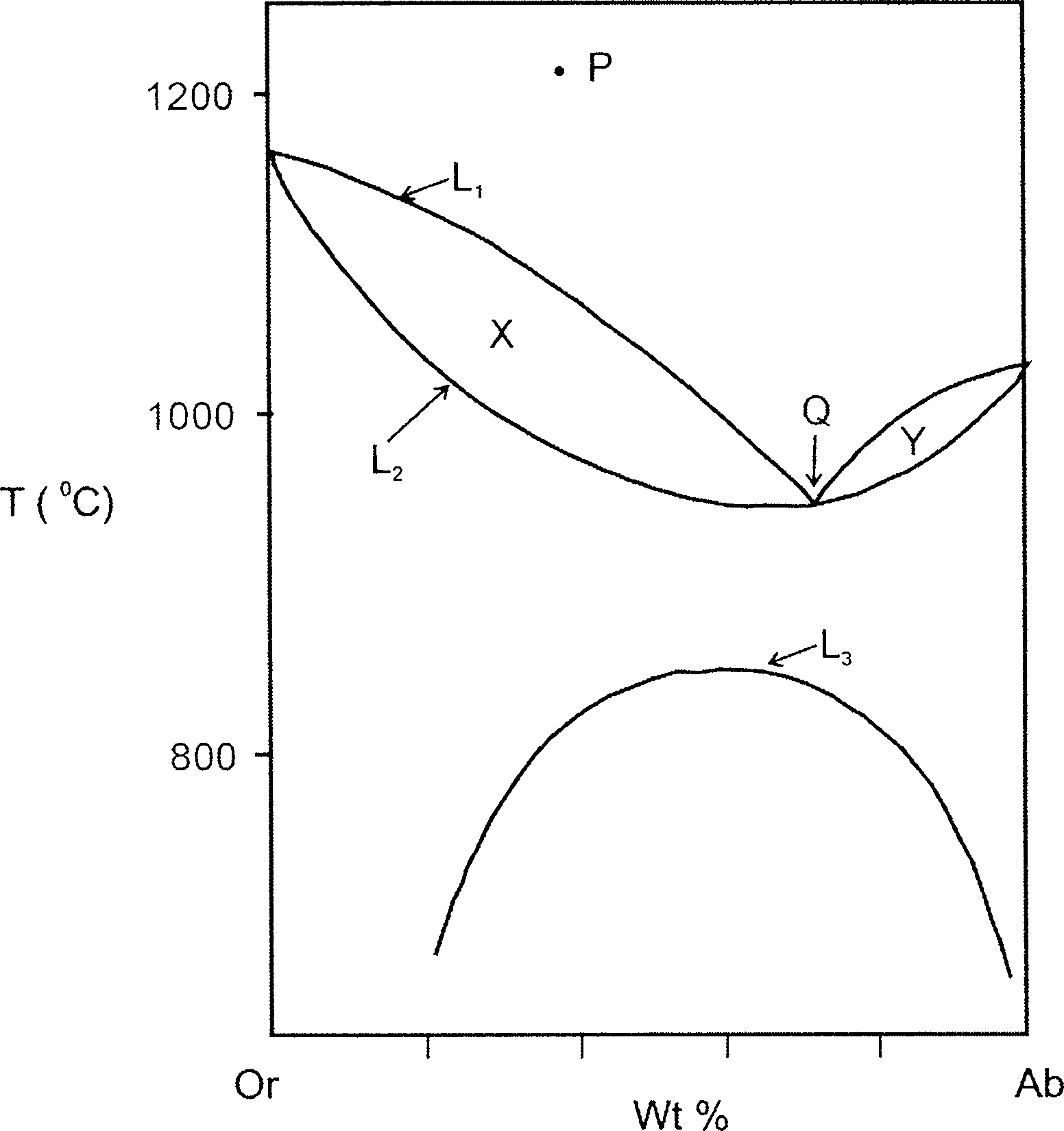
42. (a) (i) When observed under crossed nicols, a grain of quartz remains dark on 360 rotation of the stage - explain.
(ii) Why is quartz called a positive uniaxial mineral? (3 + 3)
(b) Explain the procedure of determination of sign of uniaxial minerals using a length-slow quartz wedge. (9)
The figure below is the geological cross-section of an area comprising metasedimentary sequences (A), two sedimentary sequences (B & C), batholith (D), dykes (E & F), and features I, II, III and IV. State the (i) nature of breaks in stratigraphic record, (ii) sequence of igneous activity, (iii) nature and sequence of structural disturbance, and (iv) complete geological succession in the order of younging. (3 + 3 + 6 + 3)
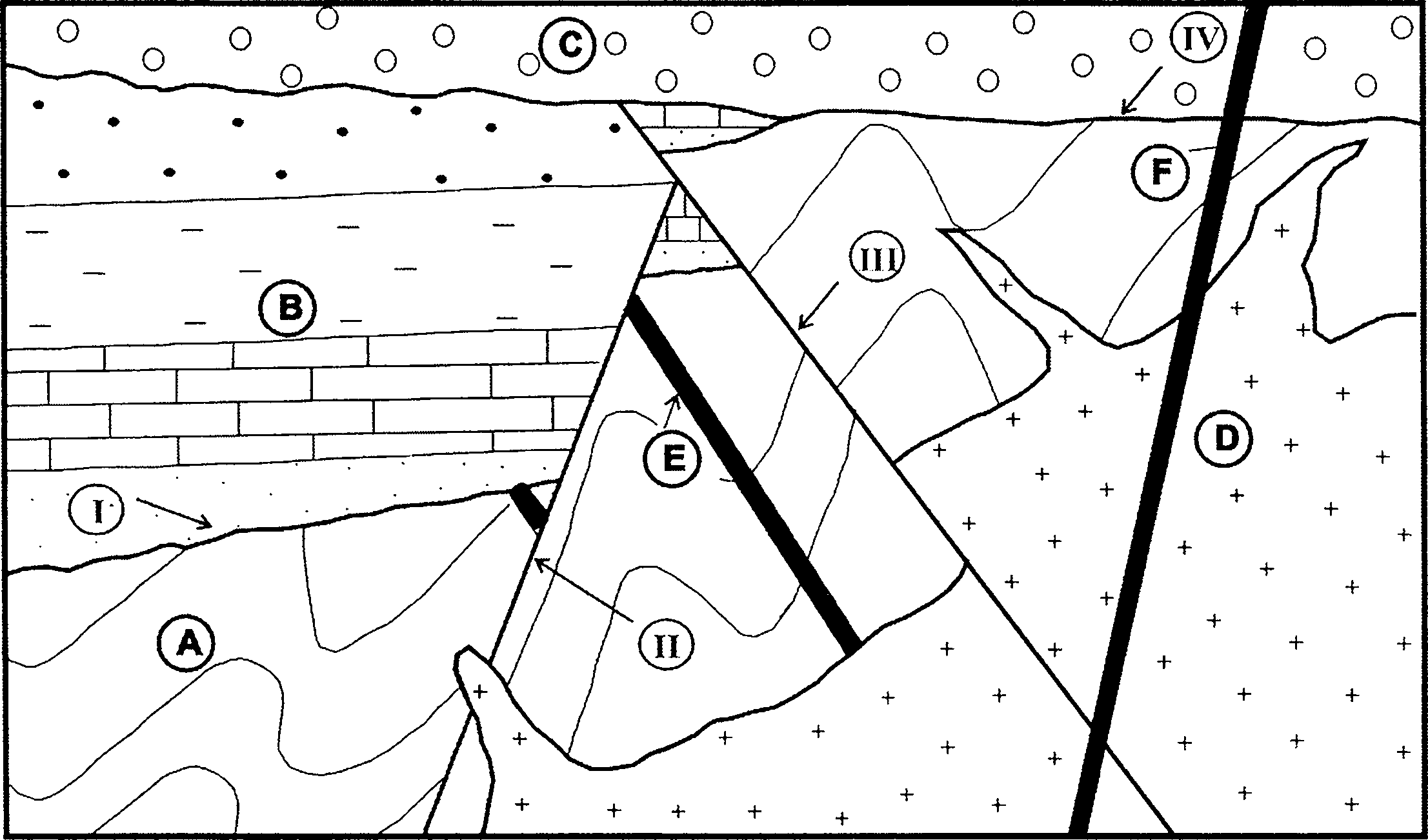
44. (a) Draw a cross-section of the interior of the earth and identify at least three different discontinuities. (9)
(b) Distinguish between spheroid and geoid. (6)
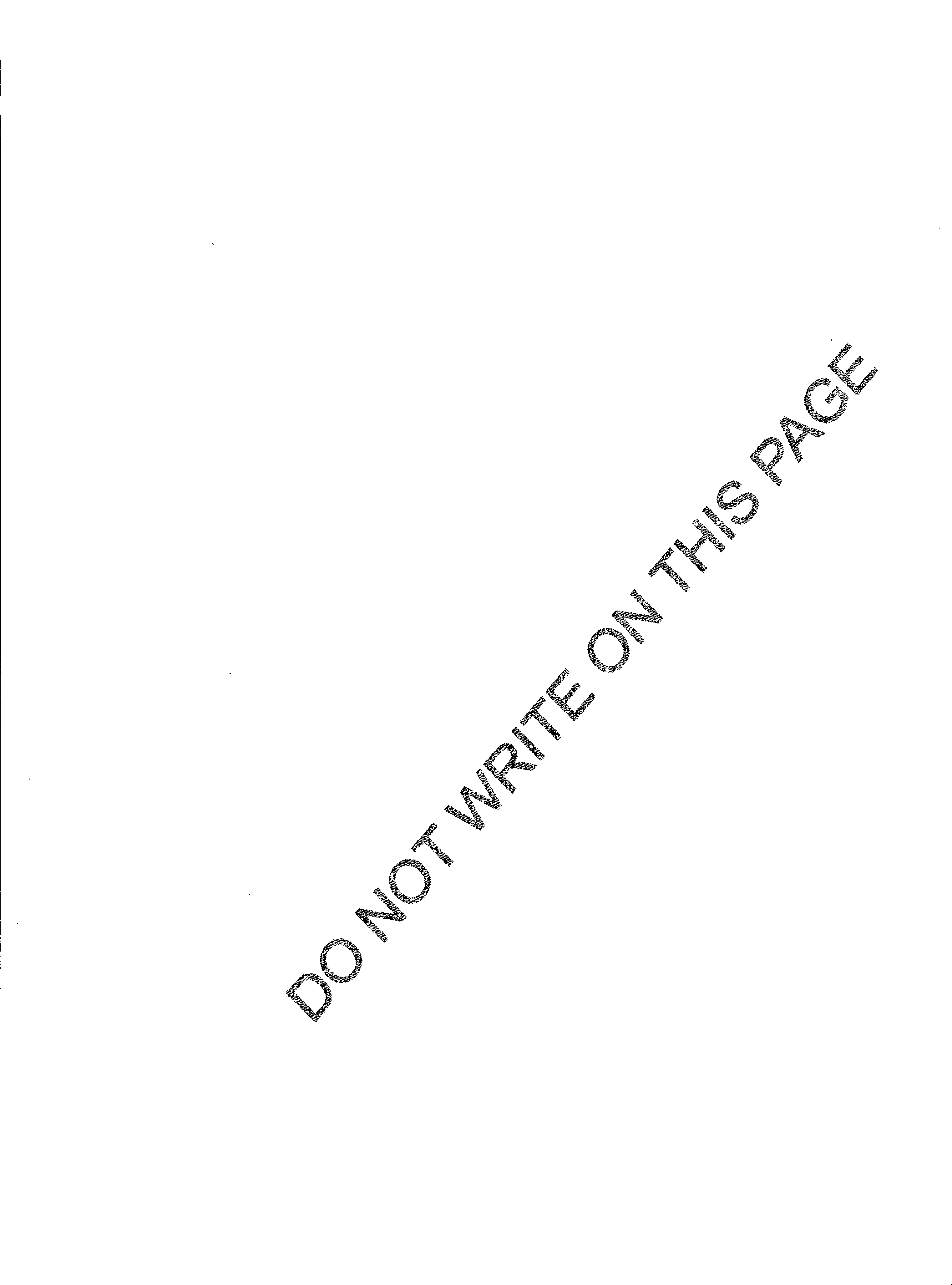
|
Attachment: |
| Earning: Approval pending. |
